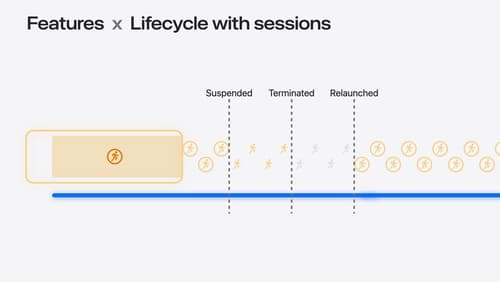how does task cancellation work?
Asked on 2024-08-02
1 search
Task cancellation in Swift can be understood through several contexts presented at WWDC:
-
TabletopKit for visionOS:
- In the context of TabletopKit, task cancellation can occur during interactions, such as when a user is dragging an object and then moves their hand behind their back. This is different from an intentional end where the user lets go of the pinch to drop the object. The update callback in the interaction object allows for modifying the interaction, including canceling it. This is an example of how task cancellation can be managed in a user interaction scenario.
-
Swift Performance:
- When dealing with async functions, task cancellation is an important consideration. If a task is cancelled, it needs to handle the cancellation properly, ensuring that any allocated resources are cleaned up and that the task does not continue executing. This is crucial for maintaining performance and avoiding memory leaks.
-
Consume Noncopyable Types in Swift:
- Task cancellation is also relevant when dealing with noncopyable types. If a task is cancelled, it is important to ensure that any resources or state associated with the task are properly cleaned up. This can involve checking for thrown errors and ensuring that any ongoing operations are properly terminated.
-
UI Animations and Transitions:
- In the context of UI animations, task cancellation can occur during transitions. For example, if a push transition is interrupted by a pop transition, the push is not cancelled but instead completes immediately, and the pop transition starts. This ensures that the UI remains in a consistent state.
For more detailed information on task cancellation in Swift, you can refer to the following sessions:
- Meet TabletopKit for visionOS (09:44)
- Explore Swift performance (24:54)
- Consume noncopyable types in Swift (06:01)
- Enhance your UI animations and transitions (06:03)
These sessions provide insights into how task cancellation is handled in different contexts within Swift and visionOS.

What’s new in location authorization
Location authorization is turning 2.0. Learn about new recommendations and techniques to get the authorization you need, and a new system of diagnostics that can let you know when an authorization goal can’t be met.

A Swift Tour: Explore Swift’s features and design
Learn the essential features and design philosophy of the Swift programming language. We’ll explore how to model data, handle errors, use protocols, write concurrent code, and more while building up a Swift package that has a library, an HTTP server, and a command line client. Whether you’re just beginning your Swift journey or have been with us from the start, this talk will help you get the most out of the language.

Meet TabletopKit for visionOS
Build a board game for visionOS from scratch using TabletopKit. We’ll show you how to set up your game, add powerful rendering using RealityKit, and enable multiplayer using spatial Personas in FaceTime with only a few extra lines of code.
